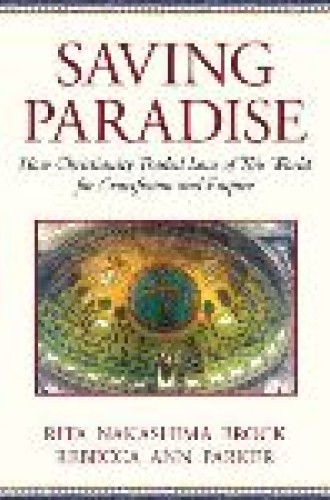Saving Paradise: How Christianity Traded Love of This World for Crucifixion and Empire
In this fascinating book, Rita Nakashima Brock and Rebecca Ann Parker contest a widely held impression of Christianity. Basing their evidence on both verbal and visual texts, they systematically unravel the notion that the crucifixion of Jesus Christ has always been central to Christian faith. Indeed, they point out, crucifixion scenes began to appear at a particular historical moment, when Carolingian emperors used violent means to establish a Christian empire. The popularity of crucifixion scenes was established as late as the end of the 11th century when violence entered theology with Anselm’s theory of atonement, and it escalated politically with the First Crusade against Muslims and Jews.
Before that, the authors argue, Christians were fascinated by and preoccupied with earthly paradise. Brilliant mosaics located in church sanctuaries pictured luxuriant growth watered by four rivers, while homilies and literature lingered on word paintings of the beauty and pleasure of paradise. Saving Paradise is well worth reading for the many beautiful quotations from patristic authors alone.
The excitement of “two Western Protestant theologians trained in the analysis of written texts and philosophical ideas” whose eyes have been opened by the visual culture of historical Christianity is evident throughout the book. The authors’ description of their pilgrimage of inquiry and discovery forms a leitmotif of Saving Paradise. They guide readers through their extensive travels to remote villages and major metropolises in search of the earliest images of Christ’s crucifixion. What they found were not crucifixion scenes but ubiquitous images and descriptions of paradise. Brock and Parker also surveyed liturgies and texts—from the Hebrew Bible, through the works of Heloise and Calvin, to those of Walter Rauschenbusch and W. E. B. Du Bois—that reveal theological and ecological interest in preserving the earthly paradise.
Part one of the book offers a detailed “genealogy of paradise,” while part two traces the simultaneous devolution of interest in the gifts and graces of this world and the growth of a piety of sacrifice and suffering. In the authors’ rereading of historical theology, different heroes and villains emerge from those of traditional church history. Authors such as Anselm and Bernard of Clairvaux and political figures like Constantine and Charlemagne become the villains of historical Christianity.
Brock and Parker discuss a fifth-century wood carving on the door of Santa Sabina in Rome that apparently undermines their claim that the earliest extant depiction of Christ’s crucifixion is the so-called Gero Cross (presently in the Cologne Cathedral), carved c. 960-970 in Saxony. Even though three figures whose hands are conspicuously nailed to blocks of wood are depicted on the Santa Sabina door, the authors contend that the scene represents not crucifixion but resurrection because “Jesus was definitely not dead.” This interpretation (also found elsewhere in the book) conflates crucifixion with death, ignoring a long tradition of regarding the crucified Jesus as a symbol of triumph. Jesus reigns from the cross, having overcome death and achieved the salvation of humanity, so crucifixion scenes have not been, and need not be, understood as representing and communicating “perpetual dying.” Eastern Orthodox theologians in particular have identified the real crucifixion event as the spiritual, not the physical, event, and many icons that depict the crucified Christ standing erect, with intact body and open eyes, reflect this understanding. The Santa Sabina crucifixion is firmly within this tradition.
At points the authors’ amazement—and frequent dismay—at their findings produces hyperbole. To wit: “Anselm argued with a relentless, constricting logic, like a snake squeezing its prey.” Or: “In the twelfth century, true love died.” And how did they get the impression that late medieval piety was “dismal”? As many medievalists have shown, late medieval piety was rich, colorful and varied. Moreover, it is not true that “wherever the Protestant Reformation spread, a passion for iconoclasm accompanied it.” Martin Luther, the prototypical Protestant reformer, declared that he would like to see Bible scenes painted not only on churches but also on houses, inside and out. Distinctive and flourishing Protestant art accompanied many reforming movements.
Yet Saving Paradise effectively communicates a powerful message. Seeing paradise is essential to saving it, as has been recognized by myriad Christians who have described the glory of creation in language, images and music. Moreover, seeing the beauty of our earthly paradise provides essential incentive for caring for it. “Paradise is already present,” the authors write, and when the crucifixion scene no longer dominates, the earth in all its beauty and vulnerability streams into our eyes. In the best tradition of theological inquiry, Saving Paradise provides a history and a theology that helps us engage the pressing problems of the world. The wealth of evidence the authors have gathered demonstrates that seeing, loving and saving paradise is neither a minor theme in the visual and verbal repertoire of the Christian traditions nor a small adjustment of the great story.
Both the cross and earthly paradise are essential to the Christian story. While crucifixes did not appear in the Christian art of the first several centuries, crosses were ubiquitous. For example, in the lush sixth-century apse mosaic at Sant’ Apollinaire in Classe in Ravenna, Italy (533-549 CE), a large cross is superimposed on a wooded meadow in which sheep face a shepherd with arms outstretched. Suffering, neither emphasized nor hidden, is symbolized by the bare cross and has its place—indeed, a central place—in paradise. The cross is not the problem; the problem is the exclusive focus on the crucified Christ that has occupied the foreground of Christians’ imaginations for centuries. In Saving Paradise, Brock and Parker have brought forward a bright thread of the Christian tapestry that had been in the background, largely ignored. In so doing they have made accessible rich and vivid theological resources.





